Audio interfaces for drums need to manage all sounds, from the deep bass drum to the sharp cymbal hits. This is essential for capturing every detail and nuance of drum sounds accurately.
- High-resolution audio capture is paramount, with interfaces offering at least 24-bit depth and 96kHz sampling rate to ensure detailed and vibrant drum recordings.
- Equally important is the interface’s ability to support multiple inputs simultaneously.
- Low latency is crucial to allow real-time monitoring without delay, keeping the drummer in sync while recording.
As we go through our top selections, remember that the ideal interface should enhance your drum recordings, faithfully reproducing every beat and nuance of your performance. Read on for a detailed “Buying Guide“ tailored to your needs, and check out the list of the best audio interfaces for drummers available on Amazon.
Outline
ToggleBest Audio Interfaces for Drums Table
| Best Audio Interface for Drums | Input Output | Audio Resolution | Latency | Buy Now |
|---|---|---|---|---|
| M-Audio Audio Interface | 2-In/2-Out | 24-bit/192kHz | Low Latency (2.59ms) | Check On Amazon |
| Behringer Audio Interface | 2 inputs / 2 outputs | 48kHz | Ultra-low latency | Check On Amazon |
| Fifine Audio Interface | One XLR input,HEADPHONE, and LINE OUT | 16-bit/48k Hz | - | Check On Amazon |
| PreSonus Audio Interface | 1x1 MIDI In/Out | 24-bit/96 kHz | Zero-latency | Check On Amazon |
| Tascam Audio Interface | 8 inputs at instrument level 8 Outputs,Two with front-panel level control | 24-bit/96 kHz | Low-latency | Check On Amazon |
Best Audio Interfaces for Drums Reviews
1. M-Audio Audio Interface
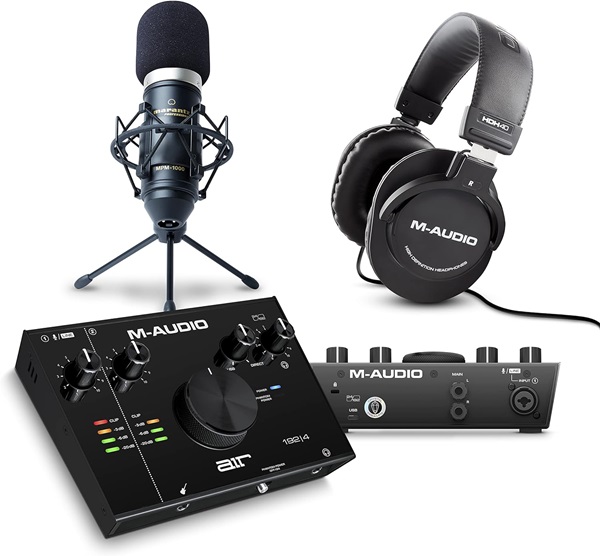
M-Audio AIR 192|4 audio interface for Drums offers a range of options to suit your needs. With USB and MIDI connectivity, you can seamlessly integrate the interface with your computer or electronic drum module. The supported software ensures compatibility with popular DAWs (Digital Audio Workstations), providing a versatile platform for your drumming creativity.
The Transparent Crystal™ preamps and ultra-pristine A/D converters set a new standard for audio recording quality, ensuring transparency and fidelity in every capture. With an impressive 24-bit/192kHz resolution, this interface guarantees the precision and clarity needed to bring your recordings to life. The VU LED metres provide a visual guide for optimal level control, adding a professional touch to your recording process.
Best Features:
- Multiple XLR and ¼” TRS Inputs.
- Dedicated Headphone Outputs for Detailed Monitoring.
- Balanced Line Outputs for Seamless Integration.
- Precision-Built Preamps for Clean and Transparent Signal Capture.
- USB and MIDI Connectivity.
- Compatible with Popular DAWs (Digital Audio Workstations).
- Captures the Full Spectrum of Drumming Dynamics.
Pros:
- Powerful Headphone Outputs.
- Sublime Mic Quality and Low Latency Performance.
- Robust Metal Chassis for Durability.
- Affordable Price Point.
- MIDI In/Out for Virtual Instruments/Drums.
- USB/Direct Knob for Flexible Sound Mixing.
- VU LED Meters with Multiple Levels.
Cons:
- Lacks Resistance.
- Device Tends to Get Hot, Especially at Higher Sample Rates.
- Popping and Noise Issues with Lower-quality Cables.
2. Behringer Audio Interface
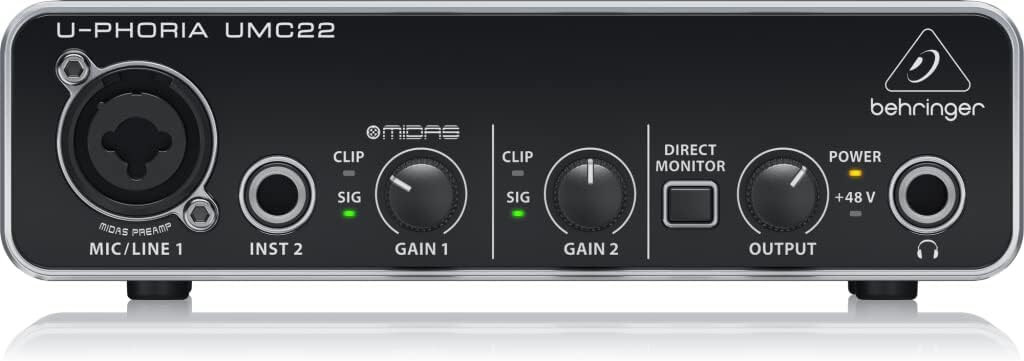
This audio interface offering seamless integration with popular recording software such as Avid Pro Tools, Ableton Live, and Steinberg Cubase. Its USB port not only facilitates a straightforward connection but also powers the interface, streamlining the setup process. The compatibility with both Mac OS X and Windows XP or higher ensures broad accessibility for users across different platforms.
Best Features:
- 2×2 USB Audio Interface.
- Midas Designed Mic Preamplifier.
- +48V Phantom Power.
- Versatile Input Options for Microphones and Instruments.
- Professional 48 kHz Resolution for High-Quality Audio.
- Instrument Input for Diverse Recording Needs.
- Streamlined 2-In/2-Out Configuration.
Pros:
- Excellent Construction and Sound Quality.
- Simple Plug-and-Play Setup.
- Affordable Price.
Cons:-
- Limited Features for Advanced Users.
- Limited Headphone/Monitor Control.
3. Fifine Audio Interface
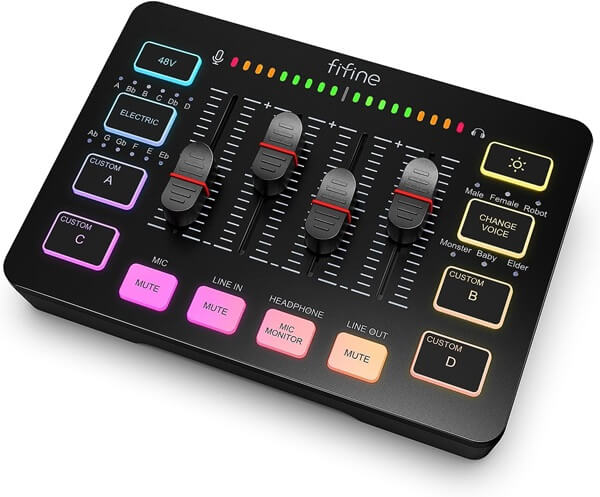
48V phantom power expands microphone compatibility, eliminating the need for additional peripherals. The gaming audio mixer supports MIDI and offers a resolution that enhances the nuances of your voice, contributing to a clear and immersive audio experience.
This plug ‘n play solution is compatible with both Mac OS and Windows, ensuring a hassle-free setup for users across different platforms. The gaming audio mixer is designed to work seamlessly with popular streaming and recording software, enhancing its versatility. Whether you’re using OBS for live streaming or engaging in online chat on platforms like Twitch, the AmpliGame SC3 offers broad compatibility and exceptional performance.
Best Features:
- Six voice-changing modes and 12 auto-tune options.
- Plug ‘n play compatibility with Mac OS and Windows.
- XLR Microphone Interface.
- Built-in 48V Phantom Power.
- Four independent channels.
- Smooth Volume Slider Fader for precise control.
Pros:
- Versatile performance for gaming, streaming, and drum playing.
- Sleek design with sturdy build and customizable RGB lighting.
- Creative sound effects with customizable buttons, voice-changing modes, and auto-tune options.
- Affordable pricing.
Cons:
- Decent but not exceptional voice changer quality.
- Limited audio profiles and effects presets.
- Occasional LED glitch where LEDs flash white randomly when turned off.
4. PreSonus Audio Interface
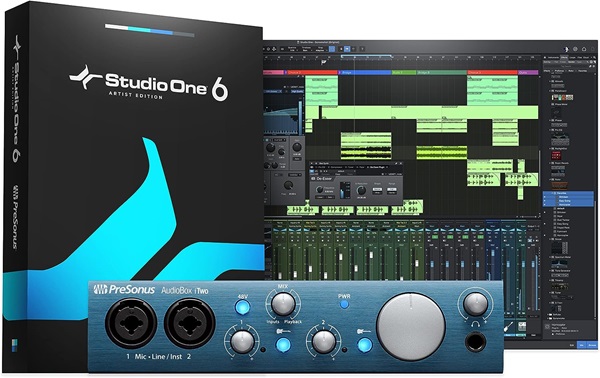
AudioBox iTwo excels with its studio-grade converters supporting up to 24-bit/96 kHz recording and playback. The Class A mic preamplifiers deliver exceptional audio performance, capturing the nuances of your recordings with clarity and detail.
USB 2.0 bus-powered design ensures compatibility with Mac, Windows, and even Apple iPad, offering a versatile solution for different setups. The inclusion of MIDI I/O expands creative options, allowing you to integrate external MIDI devices into your workflow. The internal analog mixer with a direct button enables zero-latency monitoring, ensuring real-time audio feedback during recording sessions.
Best Features:
- Compatible with Apple iPad, Mac, Windows, iOS, and iPadOS.
- Two combo microphone/instrument/line inputs.
- High-performance Class.
- Two balanced ¼” TRS main line-level outputs.
- Stereo headphone output with independent level control.
- MIDI I/O for external MIDI device integration.
- Internal analog mixer with direct button.
- Rugged metal chassis for durability.
- Large main volume knob for easy control.
- Comes with Studio One Artist DAW software (Mac/Windows) and Capture Duo for iPad recording software.
Pros:
- Solid preamps with great audio quality.
- Convenient front-facing inputs and headphone jack.
- MIDI in/out for external devices.
- Budget-friendly option.
- Comes with Studio One Artist software.
Cons:
- Concerns about audio quality, especially when using headphones.
- Potential issues with muddier and noisier music output compared to direct laptop connection.
- Quick rise in noise levels during volume adjustments.
5. Tascam Audio Interface
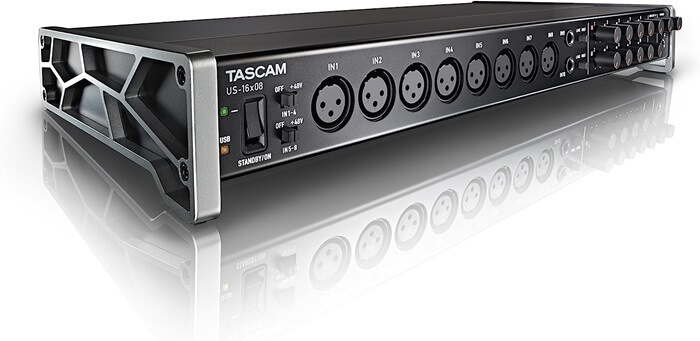
Tascam US-16×08 with discrete components for a remarkable EIN rating of -125 dBu. Achieving a signal-to-noise ratio of 100 dB, it surpasses standards in its price range, contributing to exceptional audio clarity and fidelity. Supporting up to 24-bit/96 kHz resolution, it meets professional standards for precise recording and playback.
Best Features:
- 16 mic and line inputs, 8 balanced line outputs.
- 8 preamps with up to 57dB gain, low noise, and distortion.
- Two front-panel level-controlled outputs for convenient monitoring.
- Includes MIDI input and output options.
- Ultra-HDDA preamps ensure exceptional clarity and fidelity.
- Supports up to 24-bit/96 kHz recording and playback.
Pros:
- Cost-effective alternative to the Scarlett 18i20, performs better at half the price.
- Easy and quick setup.
- Tracks 16 channels simultaneously without issues.
- Versatile for recording a fully mic’d kit with 16 mono inputs, 8 outputs, and MIDI connectivity.
- Clean and accurate sound output with balanced line outs.
Cons:
- Windows compatibility issue.
Buying Guide for Best Audio Interface For Drums
1. Input and Output Options
For capturing a drum kit effectively, it’s crucial to have an adequate number of inputs to accommodate each drum and cymbal, as they typically require dedicated microphones.
Having multiple line outputs allows you to send each drum sound to separate channels in your recording software. This is especially important if you plan to apply specific processing or effects to individual drum elements during the mixing process.
2. Audio Resolution
Resolution is measured in bits and represents the number of digital values used to represent an analog signal. Common bit depths for audio interfaces are 16-bit, 24-bit, and 32-bit.
For drum recordings, especially in a studio or professional setting, it’s advisable to opt for higher resolutions like 24-bit or 32-bit. These provide more headroom and accuracy during the recording process, allowing the interface to capture the full range of drum sounds.
In a live or casual recording scenario, a 16-bit resolution might suffice, especially if storage space is a concern, as higher bit depths result in larger file sizes. However, for critical drum recordings where fidelity is paramount, investing in an interface with 24-bit or 32-bit resolution is recommended.
3. Latency
For drummers, especially in live situations or during recording, low latency is essential to maintain the natural feel of playing. Zero latency monitoring is highly desirable as it allows musicians to hear themselves in real-time without any delay. This is particularly crucial for drummers who rely on precise timing and need to feel the immediate response of their drum hits. With zero or minimal latency, drummers can stay in sync with the beat, enhancing their performance and overall experience.
4. Phantom Power
Condenser microphones, commonly used for overheads and some drum mics, require phantom power to operate. A majority of interfaces provide 48V phantom power, which is the standard requirement for most condenser microphones. This power is necessary to energize the microphone’s internal circuitry, enabling it to capture sound with greater sensitivity and detail.
For drum recording, ensure that the audio interface you select has individual phantom power switches or controls for each input, allowing you to activate or deactivate phantom power as needed.
5. Preamps Quality
The quality of preamps is paramount when selecting an audio interface for drum recording. Preamps amplify the low-level signals from microphones, shaping the overall sound and influencing the clarity and character of the recorded drums.
Consider the number of preamps the audio interface offers and ensure it aligns with your drum miking setup. If you plan to close-mic multiple drums and cymbals, having an interface with an adequate number of preamps is essential.
6. Connectivity
Prioritize an audio interface with USB connectivity based on your recording requirements. USB 2.0 is a reliable standard, but if you anticipate handling extensive track counts, USB 3.0 or USB-C might offer advantages. Additionally, consider the number and types of inputs and outputs, ensuring the interface aligns with your current and future drum recording needs.
Best Audio Interface For Drums – FAQs
Ans: To record drums effectively, you need an audio interface with multiple inputs, suitable preamps, and low-latency performance. Look for an interface with enough channels to capture each drum and cymbal separately for optimal sound quality and flexibility during mixing.
Ans: In a standard scenario, you might require at least four to eight preamps to individually mic the kick drum, snare drum, and multiple toms, along with overhead and room mics.
Ans: To record drums professionally, ensure you have a capable audio interface with preamps and low latency, quality microphones for each drum component, essential cables, closed-back headphones, acoustic treatment for the room, a reliable digital audio workstation (DAW), MIDI controllers for electronic drums, monitor speakers, and sturdy stands for mic placement.
Ans: Audio interfaces handle actual sound signals, while MIDI interfaces transmit musical performance data between instruments and computers without conveying audio.
Conclusion
- For drummers looking for 16 channels, Tascam Audio Interface offers 16 inputs and output connectivity options. It offers cost-effectiveness, quick setup, and versatility, making it an excellent choice for recording a fully mic’d drum kit.
- For a budget friendly option Fifine Audio Interface offers 4 independent channels. With six voice-changing modes, 12 auto-tune options, and plug ‘n play compatibility, it suits streaming, and drum playing.
- For excellent performance and construction Behringer Audio Interface provides optimal performance with Midas-designed preamps. It combines excellent construction, sound quality, and affordability for a reliable drum recording solution.

